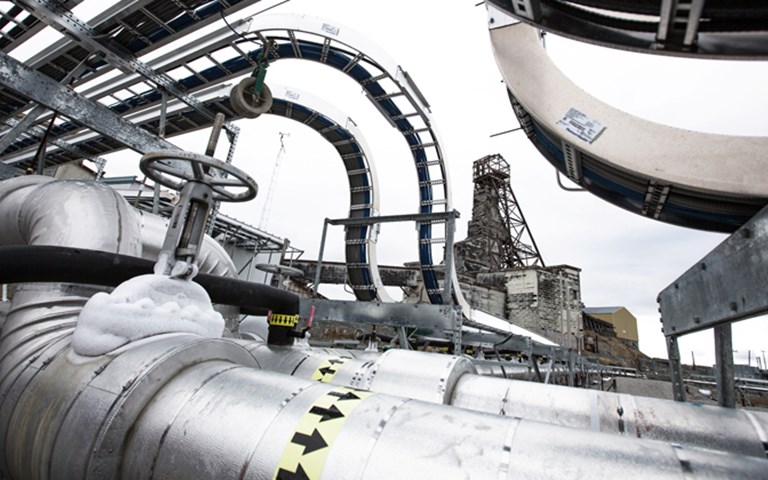The C-Shaft headframe at the Giant mine near Yellowknife is framed by piping used in a freeze optimization study that helped determine how the mine’s arsenic trioxide dust would be stored for the next hundred years | Dave Brosha Photography/AANDC
If ever there was a poster child for mining’s bad old days in Canada’s North, Yellowknife’s Giant mine would be it. Built during the North’s frontier days, when environmental regulations were lax and the concept of seeking social licence from the nearby Dene aboriginal population did not exist, a series of owners hauled more than seven million ounces of gold from open pits and underground stopes between 1948 and 2004. Left behind from the roasting process, just a few kilometres from the territorial capital, were 237,000 tonnes of arsenic trioxide dust.
Giant became the responsibility of the federal government in 1999 when its owner, Royal Oak Mines, went into receivership. Mining continued after the feds sold the mine’s assets to Miramar Mining Corporation, but the deal specified that Ottawa would retain responsibility for environmental liabilities. Miramar tapped out in 2005, focusing its energies elsewhere, and Giant was officially abandoned.
What remains is one of the worst contaminated sites in the country. Ottawa estimates it will cost nearly $1 billion to overhaul the site. The scope of the work is staggering: five arsenic-laden roaster buildings remain to be dismantled after another five were taken down last year; an entire creek must be realigned and possibly even diverted around the site; 95 hectares of tailings need to be capped; and the arsenic has to be contained for at least 100 years. There are countless other, smaller tasks adding to the workload. The realignment of a seven-kilometre stretch of the Ingraham Trail – the highway that once connected Giant and several legacy mines of the Yellowknife Greenstone Belt with the N.W.T. capital – was completed this year by the Government of the Northwest Territories (GNWT) at a cost of $16 million.
Dismantling vs. demolishing
The roaster complex deconstruction continued this summer fronted by California-based remediation firm Parsons Ltd., under a two-year, $27-million contract. Crews spent all of last summer decontaminating 10 buildings and structures spread over a hectare. All told, says Clint Miller, senior project manager for Parsons Canada, a crew of more than 60 workers removed 2,000 tonnes of arsenic that will eventually be stored underground and another 7,000 pounds of other pollutants such as mercury and polychlorinated biphenyls that were destroyed off site.
Removing the contaminants was a painstaking process, Miller says. Each structure had to be enclosed in shrink wrap, then essentially vacuumed out with high-efficiency particulate air (HEPA) filters to trap the toxic dust. The materials were then pressure washed and scraped with wire brushes before finally being coated with a water-based sealant.
All of those buildings are to be dismantled this year. “One of the words we don’t use is ‘demolition,’” Miller says. “That would imply an uncontrolled destruction of a building. What we will be doing here is a very controlled process. We remove the hazardous materials and then we deconstruct the building piece by piece.”
There is also the matter of lingering arsenic pollution in the soil around the Giant site. Until 1951, the mine’s owners made no effort to prevent arsenic released during roasting from getting into the environment. After a local Dene boy died from drinking arsenic-poisoned water that spring, Giant’s owner installed an electrostatic precipitator and began underground storage of arsenic tailings.
A unique catastrophe
Heather Jamieson, an arsenic expert at the department of geological sciences and geological engineering at Queen’s University in Kingston, has been studying the arsenic at Giant for 15 years. She says around 85 per cent of Giant’s roaster stack arsenic emissions date from before 1963. At similar sites around the world, arsenic in the soil appears to dissipate over time. That is not the case at Giant, something that has stumped researchers. “It is kind of surprising to a lot of chemists and geochemists that the arsenic trioxide has persisted in the soil,” she says, “because at some other places in the world they don’t seem to be able to find it.”
Jane Amphlett, operations manager for the project for Aboriginal Affairs and Northern Development Canada (AANDC), says monitoring stations both at the mine site and located around Yellowknife are designed to detect elevated levels of arsenic in the air. The community data is available in real-time on the GNWT air quality website, and reports from all stations are released once a week to the public.
All this work sets the stage for the centrepiece of the remediation project: what AANDC officials call the “freeze program.” The 237,000 tonnes of arsenic trioxide dust is stored underground in the existing network of underground chambers and stopes. The plan is to use a network of thermosyphons to freeze the rock surrounding these stopes, keeping this arsenic secured inside for at least a century. A thermosyphon functions passively by using pressurized carbon dioxide (CO2). The process works as a continuous cycle; the underground CO2 vaporizes into gas and rises to the surface, allowing the heat from below to be released into the cold winter air through radiator fins. The CO2 then cools and condenses into liquid, dribbling back down toward the stopes to begin the process again.
The freeze program is expected to be the single largest construction cost item of the remediation at around $200 million, and is likely to require the longest period to implement – up to 10 years.
The logistics of the freeze program are daunting. Some of the cavities are the size of a 12-storey office building, Amphlett says, and many of the stabilizing bulkheads date back to the earliest days of mining at Giant and have to be reinforced with concrete.
Much of the dust has been stored underground for years or even decades. Over the years, mine owners stored the arsenic dust in either purpose-built chambers or exhausted mining stopes. Daryl Hockley, a technical advisor with SRK Consulting, says the chambers are relatively symmetrical and will be easy to freeze and fill. SRK is retained as a technical advisor for the remediation. “Where a chamber was built in a relatively rectangular shape and there’s only one entrance, you simply have to block off that entrance,” he says. Any pipes used to fill the chambers with dust have to be removed and placed inside, then “you can pretty much proceed with freezing at that point.”
The stopes, which were mined to follow gold veins, are not so simple, Hockley says. “They tend to have a lot more entrances and exits,” he notes. “There will be ore passes, there will be cross-cuts, [and] there will be all sorts of other odd geometries that only mining engineers can tell you what they mean. In some cases we’ll need to do some mining so we can stabilize the entrances properly. Each one is a little mini-project on its own.”
The project engineers are confident the freeze program will keep the arsenic in place. The N.W.T.’s long, frigid winters help, of course, and Hockley says the rock encasing the dust would stay frozen for “many years” before any dust began to thaw, even in the unlikely scenario that the cooling system failed completely. “That’s part of the beauty of the plan. Even if there’s a problem with the thermosyphons [we have] several years to respond and adjust.”
Not everyone in Yellowknife is pleased with the approach. Some local activists would prefer to see the arsenic removed completely and disposed of elsewhere because they are still worried arsenic could leach into the local environment. That is one of the reasons the Mackenzie Valley Environmental Impact Review Board ordered AANDC to amend the project’s timeframe: Instead of storing the arsenic in perpetuity, as was the original plan, the project will be re-assessed in 100 years and the government will need to re-evaluate the best way to dispose of the arsenic at that time.
Jamieson says those Yellowknifers are right to be concerned, but adds that the Giant site is largely off limits to the public, which reduces the risk of exposure. Meanwhile, the story is constantly front and centre in the N.W.T. press, and a dedicated project team has been established by the federal and territorial governments to oversee the cleanup. “An advantage of a publicly managed site is that there is the opportunity for people to communicate their concerns,” says Jamieson.




